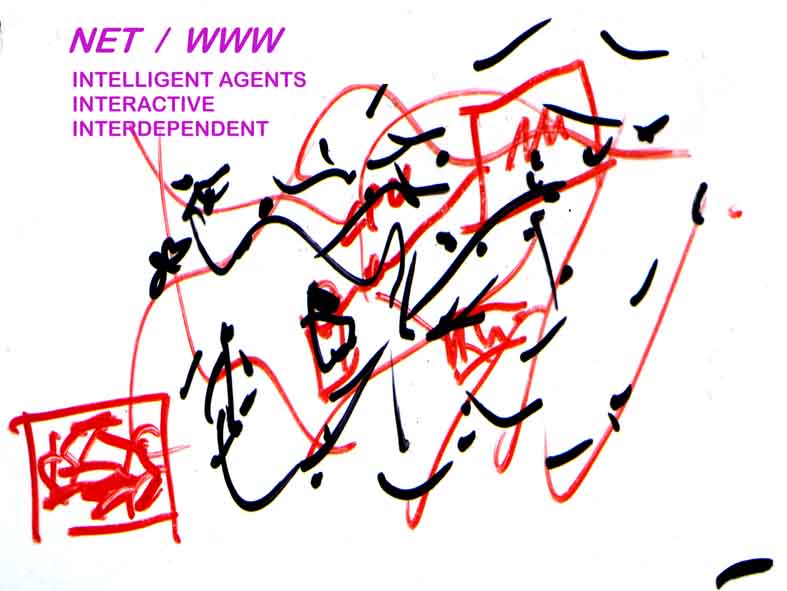


Infotube (Matsumoto/Matsukawa/Wakita) ................. Informationsräume
| Manfred Wolff-Plottegg Architektur als Informations-Editor | schon: 04.02.2002 13:05 >>>>>>>> English |
Wenn ich behaupte, ich hätte etwas mit dem kleinen Finger (oder "mit links") gemacht, ist das, wie üblich, ein understatement; es gibt aber auch Leute ("Der Bauch des Architekten"), die sagen sie machen etwas aus dem Bauch - weil sie dort sehr viele Nerven zusammenlaufen hätten -, während andere hirnlastig behaupten, es komme aus dem Kopf; Und derzeit wird vieles dem Computer zugeordnet. Wo nun die Prozessoren sind, war früher eventuell ein Thema der location (traditionell genius loci), mit der Erfahrung der Dislokation könnten wir nun rückblickend meinen, daß sich topografische Unterschiede zumeist nicht wirklich per autochtonen Ergebnissen nachweisen lassen. Aber es bleiben die Fragen: wie kommen die Striche aufs Papier und wie kommen die Häuser auf die Wiese?
Architektur
Informationsverarbeitung I:
Eine Klientin kam zu mir, sie wollte ein Haus für den Rückzug im Alter,
mit Dach und Balkon (so zwischen salzburgisch und tirolerisch), ein Haus nach Wunsch,
belegt durch einen Stapel von (Urlaubs- und Erinnerungs-) Fotos, einige "schöner
Wohnen"-Bücher: also der englische Kamin, das französische Fenster, die Terrasse
wie damals auf Urlaub in Griechenland, natürlich italienisches Terrakotta und spanisch
schweres Holz, ein wenig Biedermeier, aber schon mit Blumenfenster und auch etwas
Bio&Öko sollte dabei sein - ein architektonisches Bilderpuzzle. Es ist sinnlos
Informationen zu sammeln, wenn die Regeln der Verarbeitung nicht bekannt sind.(1)
Alle Häuser der Häuslbauer sind ein selbstähnliches Limesbild. Obwohl jeweils genau das
eigene individuelle Wunschbild - all you need is love.... - behauptet wird,
manifestiert sich in der Selbstähnlichkeit ein Microzensus, ein kollektiver
Favoriten-Gedankengang: das schon Dagewesene, der Gefallen, ...... Wenn das Ergebnis eine
Kopie des Wunschbildes ist, wenn es also ohnehin schon bekannt ist: worin besteht
"Informationsverarbeitung", wenn nichts verarbeitet wird? analog oder digital?
> merge, morph, copy/paste; > wie bei den SIRD-Sehweisen (2)
springt das Limesbild ins Auge.



Infotube (Matsumoto/Matsukawa/Wakita) .................
Informationsräume
Architektur Informationsverarbeitung III:
|
> > > > > > > |
 |
"der planende Architekt" |
"Das Binäre Haus" |
Architektur
Informationsverarbeitung IV:
Der Neuronale Architektur Generator(6) -
eine Installation bestehend aus zwei miteinander kommunizierenden digitalen Prozessoren,
deren Output projiziert wird - geht davon aus, daß Pulsfolgen (spike trains) in
biologischen Organismen gleich = binäre Zeichenreihen (bit strings) gleich = Daten
(Koordinaten, Vektoren) interpretierbar als geometrische Volumen (solids) sind. Diese
Gleichung verknüpft drei traditionell als wesensfremd angesehene Wirklichkeitsbereiche:
die Welt in unserem Kopf: Informationen, Vorstellungen und Ideen wie sie in biologischen
Organismen tatsächlich kodiert sind; die Welt der digitalen Datenverarbeitung,
repräsentiert durch binäre Zeichenreihen als Vokabular der Kommunikation zwischen
digitalen Prozessoren; die Welt der Generierung neuer Bilder / Räume / Architekturen.
Diese drei Wirklichkeitsbereiche werden hier auf dem gemeinsamen Nenner der
Informationsverarbeitung miteinander verknüpft. Die Installation demonstriert auf diese
Weise, dass die Generierung von Bildern/Räumen/Architekturen nicht mehr anthropozentrisch
/ expressionistisch gesehen werden muß. Durch die Computeranwendung wird sozusagen ein
Schritt der Emanzipation von althergebrachten Verhaltens-, Evaluations- und
Produktionsmustern ermöglicht.
|
 |
Trotz der vergleichsweise geringen Komplexitaet des Prototyps des Neuronalen Architektur Prozessors erscheinen die daraus gewonnenen outputs differenzierter als die der bisherigen analogen Architektur-Produktion (bei gleichen Randbedingungen). Dies hat Konsequenzen fuer unsere Auffassung von Kunst, Architektur und menschlicher bzw. maschinell/digitaler Kreativitaet: es beweist unsere These, daß die Kreativität (hier Produktion von Architekturbildern) ein Produkt eines "neuronalen Prozessors" ist und als solche durchaus vom "Hirn" losgelöst werden kann.
Architektur Informationsverarbeitung V:
|
 |
"wir sind 3 Grab - Pyramiden" |
|
Auch der Städtebau beschäftigt sich heute gezwungener Maßen mit Prozeßsteuerung, Architektur ist nicht mehr Gebäude oder Objekt, Urbanismus nicht Funktion sondern Organ. Wir können gezielt den Aspekt Architektur als Medium (sehr langsam) und als Prozeß forcieren, und eine Architektur der Beschleunigung betreiben. Somit wird klar, daß diese avancierte Architektur relativ wenig mit dem persönlichem Gefallen (abgestimmt mit Bauch und Hirn) zu tun hat, viel eher mit "externen" Abläufen und globaleren Systemvariablen: Produkt > Werkzeug > Werkzeugmaschine > Programm > Programmsteuerung > Systemsteuerung ...... Nach Ursache&Wirkung, Mitbestimmung und Interaktion, Grundlagen, Paradigmen, Teilsystemen, Systemveränderungen, Systemplanung, offenen Systemen, nach Linearität, Regelkreisen, Baumstrukturen, Fraktalen, Chaos sind nun selbstgenerierende Systeme zur Disposition, über Prozeßsteuerung hinaus, eine Architektur der Avatare, die Vision von autokatalytischen Bauteilen.
Architektur Informationsverarbeitung VI:
PS.:
Information Architekturverarbeitung VII:


NY / Times-Square
Traditionelle Architektur gab natürlich Informationen, war
Bedeutungsträger: ich bin eine Kirche, ich bin Macht, ich bin Zeichen, (8).......
Nun gibt es soviel Information, daß die Gebäude verschwinden (wie im Urwald von
Borobudur), Formen und Funktionen verschwinden, Architektur reduziert sich zum Gerüst
für Oberflächen (Benutzeroberflächen, Informationsoberflächen). Die Fronten sind
gewechselt: hier verarbeitet die Information die Architektur, Informationen bestimmen die
Handlungsweisen: Beschleunigung der Architektur
| Manfred Wolff-Plottegg Architecture as Information Editor | already: 04.02.2002 13:05 >>>>>>> German |
When I claim I have done something with my "little finger" (with no effort at all), this is, as usual, a slight exaggeration; however, there are people ("The Belly of an Architect") who say their work originates from a gut level – because for them that is where a whole lot of nerves converge – while others again claim, more cerebrally, that it comes from the brain; and today many things are ascribed to the computer. Where the processing actually takes place was perhaps once an issue of location (traditionally the genius loci), but with our growing experience of dislocation, we might now, in retrospect, have to admit that topographical differences cannot be accounted for by autochthonous factors. But the questions remain: how do lines get drawn on paper and how do houses appear in the field?
Architecture information processing I:Architecture information processing II:
Classical architectural theory is based upon information processing. And yet in
competitions (with, for example, 100 projects) quite different solutions may be found and,
if we supply even more information, the results do not become distinctively different. One
might say that this is not serious information processing.(3) In the
case of the own home-builder, we see an example of how conventional sources and
manipulations are obsolete: only beginners analyse a site or a set of requirements as
parameters for designing; only romantics and information scientists confide themselves to
their architect in this way, under the belief that architecture is an information
apparatus.(4)
If we are no longer useful in a world without a subject / object, if we are aimless,
desireless and placeless, information floats without obligation. The Binary House (5) is architecture production in that it produces information for
interpretations, manipulation of information as a generator of architecture.



|
> > > > > > > |
 |
"the planning architect" |
"The Binary House" |
|
 |
Despite the relatively low degree of complexity of this Neuronal Architecture Processor prototype, the results are more differentiated than those arising out of a traditional analogue architectural production (under the same base conditions). This has consequences for our understanding of art, architecture and human versus machine/digital creativity: it proves our thesis that creativity (in this case production of architectural images) is the result of a "neuronal processor" and as such can be freed from the brain.
Architecture information processing V:
|
 |
we are 3 grave-pyramids |
I am a bit |
Even urban design today is forced to focus on process control; architecture is no longer either a building or an object; urbanism is no longer function but an organ instead. We can specifically promote the aspect of architecture as a medium (rather slow) and as a process, by producing an architecture of acceleration. It becomes clear, then, that this advanced architecture has relatively little to do with personal liking (harmonised with one’s gut and brain), but rather with "external" processes and more global system variables: product > tool > tool-producing machine > program > program control > system control. After cause&effect, co-determination and interaction, basics, paradigms, subsystems, system changes, system planning, open systems, after linearity, control circuits, tree structures, fractals and chaos, now self-generating systems are at hand, above and beyond process control, an architecture of avatars, the vision of autocatalytic components.
Architecture information processing VI:


NY / Times Square
Traditional architecture, of course, gave information, it was a carrier of meaning: I am a church, I am power, I am a sign, .......... (8)
Today there is so much information that buildings disappear (as in the jungle of Borobudur), forms and functions vanish, architecture is reduced to a framework for surfaces (user interfaces, information interfaces). The paradigms have changed: here, information processes architecture, information determines procedures: acceleration of architecture.
(1) Dieser Auftrag fand ein schnelles Ende,
die Klientin nahm sich zur Verarbeitung ihres inputs einen anderen Architekten.
(2) single image random dot
(3) Und aus der Summe der Gleichheiten
bzw. Unterschiedlichkeiten lassen sich keine verläßlichen Schlüsse auf die gemeinsamen
Vorgaben ziehen.
Architektur blufft mit der Verläßlichkeit und Stringenz der
Informationsverarbeitung.
(4) Manager glauben zumeist,
Architektur sei das Ergebnis von Entscheidungen.
(5) Projekt und Theorie: Plottegg schon 1988
(6) Neuronal Architecture Generator von
Manfred Wolff-Plottegg & Wolfgang Maass; Prototype 1999 für die Ausstellung
"Veal Virtualities" Künstlerhaus Wien und
update 2000 in "Plottegg´s Plots" Neue Galerie Graz;
Programmierung: Harry Burgsteiner / Andreas Gruber (Technische Universität Graz)
(7) M. Plottegg (Architekturalgorithmen 1996;
Das Rezept für Rezepte, 1998)
(8) siehe hiezu auch: Robert Venturi Learning
from Las Vegas
(1) This contract was
short-lived; the client employed another architect to process her input.
(2) single image random dot
(3) And from the sum of similarities or differences we cannot
draw any reliable conclusions as to the common defaults. Architecture bluffs with the
reliability and
stringency of information processing.
(4) Managers generally
believe that architecture is the result of decisions.
(5) Project and theory:
Plottegg already in 1988
(6) Neuronal Architecture
Processor by Manfred Wolff-Plottegg & Wolfgang Maass; Prototype 1999 for the
exhibition "Real Virtualities" Künstlerhaus Wien and update
2000 in "Plottegg´s Plots" Neue Galerie Graz;
programming: Harry Burgsteiner / Andreas Gruber (Graz University of Technology)
(7) M. Plottegg (Architektur
Algorithmen 1996;The recipe for recipes, 1998)
(8) cf: Venturi Learning from Las Vegas